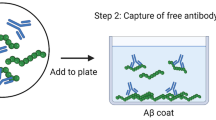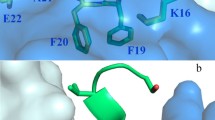Abstract
Affinity chromatography has, for many years, been at the research forefront as one of the simplest although highly versatile techniques capable of identifying biologically relevant protein-protein interactions. In the field of amyloid disorders, the use of ligands immobilized to a variety of affinity matrices was the method of choice to individualize proteins with affinity for soluble circulating forms of amyloid subunits. The methodology has also played an important role in the identification of proteins that interact with different amyloidogenic peptides and, as a result, are capable of modulating their physiological and pathological functions by altering solubility, aggregation propensity, and fibril formation proclivity. Along this line, classical studies conducted in the field of Alzheimer’s disease (AD) identified clusterin as a major binding protein to both circulating soluble Aβ as well as to the brain deposited counterpart. The affinity chromatography-based approach employed herein, individualized clusterin as the major protein capable of binding the amyloid subunits associated with familial British and Danish dementias, two non-Aβ neurodegenerative conditions also exhibiting cerebral amyloid deposition and sharing striking similarities to AD. The data demonstrate that clusterin binding ability to amyloid molecules is not restricted to Aβ, suggesting a modulating effect on the aggregation/fibrillization propensity of the amyloidogenic peptides that is consistent with its known chaperone activity.
Access this chapter
Tax calculation will be finalised at checkout
Purchases are for personal use only
Similar content being viewed by others
References
Calero M, Rostagno A, Frangione B, Ghiso J (2005) Clusterin and Alzheimer’s disease. Subcell Biochem 38:273–298
Calero M, Rostagno A, Matsubara E, Zlokovic B, Frangione B, Ghiso J (2000) Apolipoprotein J (clusterin) and Alzheimer’s disease. Microsc Res Tech 50:305–315
DeMattos RB, Brendza RP, Heuser JE, Kierson M, Cirrito JR, Fryer J, Sullivan PM, Fagan AM, Han X, Holtzman DM (2001) Purification and characterization of astrocyte-secreted apolipoprotein E and J-containing lipoproteins from wild-type and human apoE transgenic mice. Neurochem Int 39:415–425
deSilva H, Harmony J, Stuart W, Gil C, Robbins J (1990) Apolipoprotein J: structure and tissue distribution. Biochemist 29:5380–5389
Kirszbaum L, Bozas S, Walker I (1992) SP4040, a protein involved in the control of the complement pathway, possesses a unique array of disulfide bridges. FEBS Lett 297:70–76
Schwarz M, Spath L, Lux CA, Paprotka K, Torzewski M, Dersch K, Koch-Brandt C, Husmann M, Bhakdi S (2008) Potential protective role of apoprotein J (clusterin) in atherogenesis: binding to enzymatically modified low-density lipoprotein reduces fatty acid-mediated cytotoxicity. Thromb Haemost 100:110–118
Song HB, Jun HO, Kim JH, Yu YS, Kim KW, Min BH, Kim JH (2013) Anti-apoptotic effect of clusterin on cisplatin-induced cell death of retinoblastoma cells. Oncol Rep 30:2713–2718
McDonald JF, Nelsestuen GL (1997) Potent inhibition of terminal complement assembly by clusterin: characterization of its impact on C9 polymerization. Biochemist 36:7464–7473
Matsubara E, Frangione B, Ghiso J (1995) Characterization of apolipoprotein J-Alzheimer’s Aβ interaction. J Biol Chem 270:7563–7567
Wyatt AR, Yerbury JJ, Wilson MR (2009) Structural characterization of clusterin-chaperone client protein complexes. J Biol Chem 284:21920–21927
Beeg M, Stravalaci M, Romeo M, Carrá AD, Cagnotto A, Rossi A, Diomede L, Salmona M, Gobbi M (2016) Clusterin binds to Aβ1-42 oligomers with high affinity and interferes with peptide aggregation by inhibiting primary and secondary nucleation. J Biol Chem 291:6958–6966
Yerbury JJ, Poon S, Meehan S, Thompson B, Kumita JR, Dobson CM, Wilson MR (2007) The extracellular chaperone clusterin influences amyloid formation and toxicity by interacting with prefibrillar structures. FASEB J 21:2312–2322
Ghiso J, Matsubara E, Koudinov A, ChoiMiura NH, Tomita M, Wisniewski T, Frangione B (1993) The cerebrospinal fluid soluble form of Alzheimer’s amyloid beta is complexed with SP40,40 (apolipoprotein J), an inhibitor of the complement membrane attack complex. Biochem J 293:27–30
Zlokovic B, Martel C, Matsubara E, McCombo JG, Zheng G, McCluskey RT, Frangione B, Ghiso J (1996) Gp330/megalin: probable role in receptor-mediated transport of apolipoprotein J alone and in a complex with Alzheimer’s amyloid b at the blood-brain and blood-cerebrospinal fluid barriers. Proc Natl Acad Sci U S A 93:4229–4234
Vidal R, Frangione B, Rostagno A, Mead S, Revesz T, Plant G, Ghiso J (1999) A stop-codon mutation in the BRI gene associated with familial British dementia. Nature 399:776–781
Vidal R, Ghiso J, Revesz T, Rostagno A, Kim E, Holton J, Bek T, Bojsen-Moller M, Braendgaard H, Plant G, Frangione B (2000) A decamer duplication in the 3′ region of the BRI gene originates a new amyloid peptide that is associated with dementia in a Danish kindred. Proc Natl Acad Sci U S A 97:4920–4925
Rostagno A, Tomidokoro Y, Lashley T, Ng D, Plant G, Holton J, Frangione B, Revesz T, Ghiso J (2005) Chromosome 13 dementias. Cell Mol Life Sci 62:1814–1825
Calero M, Rostagno A, Ghiso J (2012) Search for amyloid-binding proteins by affinity chromatography. Methods Mol Biol 849:213–223
Hermanson GT, Mallia AK, Smith PK (1992) Natural supports. In: Hermanson GT (ed) Immobilized affinity ligand techniques. Academic, Press, pp 6–9
Edman P (1950) Method for the determination of aminoacid sequences in peptides. Acta Chem Scand 4:283–293
Niall HD (1973) Automated Edman degradation: the protein sequenator. Methods Enzymol 27:942–1010
Ovodenko B, Rostagno A, Neubert TA, Shetty V, Thomas S, Yang A, Liebmann J, Ghiso J, Ritch R (2007) Proteomic analysis of exfoliation deposits. Invest Ophthalmol Vis Sci 48:1447–1457
Acknowledgments
This work was supported by grants from the National Institutes of Health NS051715 to AR and AG030539, AG065651, and AG059695 to JG and from CIBERNED and the Spanish Ministry of Science (SAF2016-78603-R) and Institutional grants from the Queen Sofia Foundation, CIEN Foundation and the Carlos III Institutes of Health to MC.
Author information
Authors and Affiliations
Corresponding author
Editor information
Editors and Affiliations
Rights and permissions
Copyright information
© 2022 Springer Science+Business Media, LLC, part of Springer Nature
About this protocol
Cite this protocol
Rostagno, A., Calero, M., Ghiso, J. (2022). Identification of Clusterin as a Major ABri- and ADan-Binding Protein Using Affinity Chromatography. In: Ayyar, B.V., Arora, S. (eds) Affinity Chromatography. Methods in Molecular Biology, vol 2466. Humana, New York, NY. https://doi.org/10.1007/978-1-0716-2176-9_4
Download citation
DOI: https://doi.org/10.1007/978-1-0716-2176-9_4
Published:
Publisher Name: Humana, New York, NY
Print ISBN: 978-1-0716-2175-2
Online ISBN: 978-1-0716-2176-9
eBook Packages: Springer Protocols




